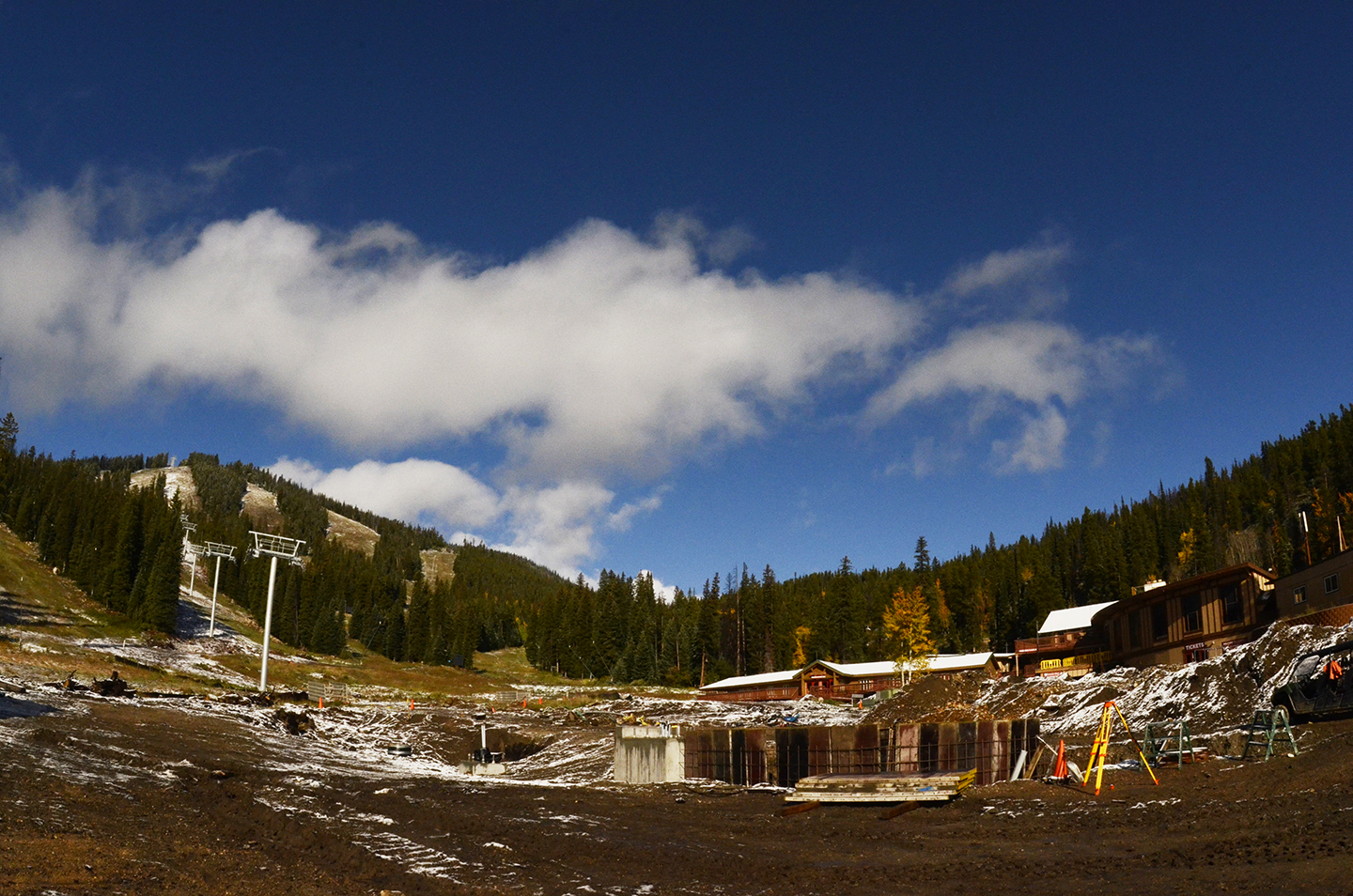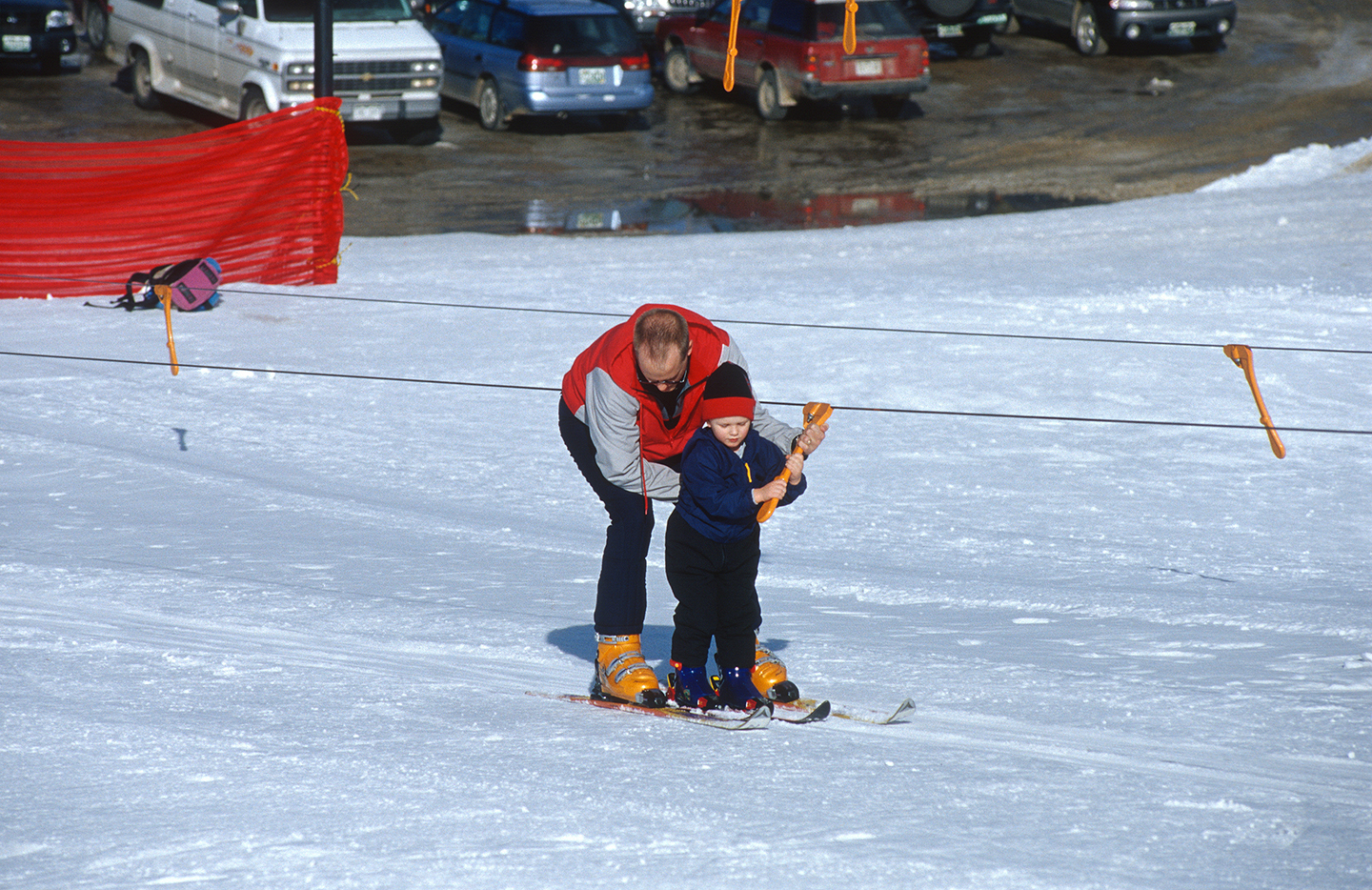
From Bret Tregaskis’ office on a late fall day, you can look out at the most visible manifestation of the changes occurring at Boulder County’s only ski area. Eldora Mountain Resort’s new six-pack high-speed quad is slowly rising from the mud of a parking lot wetted by a fall snowstorm, and the re-aligned bottom terminal dominates the view.
I’m at Eldora meeting with Tregaskis and Eldora’s newly minted director of communications, Sam Bass. Both men are ski industry veterans, albeit from very different backgrounds. Tregaskis, Eldora’s general manager, spent 17 years at Big Bear Mountain, a 748-acre operation perched on the edge of the San Bernadino Mountains above Los Angeles. A two-and-a-half-hour drive from legendary So-Cal surf breaks like Trestles and T-Street, the mountain chalks up a mere 80 inches of snow a year and, because of its proximity to the coast and the action sports culture of Southern California, is known for a vibrant snowboarding scene anchored by the ski area’s terrain park and half pipe.
Bass, on the other hand, is a long-time Boulder resident who spent years as a ski journalist, heading up titles like Skiing Magazine and covering all aspects of the sport. He landed at Eldora after a short stint in the public relations and brand management world with Backbone Media, an agency in Carbondale, Colorado, that counts some of the outdoor industry’s major players as clients. He’s only a few weeks into the new job, and his excitement is palpable.

The new lift, a $5.5 million investment, is only one of the changes that will greet skiers and snowboarders at Eldora this season. According to Bass and Tregaskis, the ski area’s new owners, Utah-based Powdr Corp, which purchased the mountain in 2016 from an ownership group headed by Bill Killebrew, are making up for lost time, revamping both the visible amenities — bathrooms and food service are getting a makeover — as well as essential but non-visible infrastructure, such as electrical systems. The latter makes a difference: with improved reliability, the mountain will avoid power outages and can also support things like an upgraded Wi-Fi system for guests.
At most ski areas in Colorado, these improvements would be par for the course. Vail Resorts, for example, has made a religion out of replacing outdated chairlifts with modern, high-speed lift infrastructure, with this year’s new Northwoods high-speed, six-person chair the 10th new lift in the last 11 years on Vail Mountain.
However, at Eldora, these investments are notable for the fact that they involve some eye-watering dollar figures for a local mountain that doesn’t see the kind of destination tourism traffic that defines ski resorts like Breckenridge (1,600,750 skier visits in 2016) or Vail (1,634,250 skier visits in 2016). They’re also symbolic of a more nuanced cultural shift at Eldora that’s a welcome change from the sometimes combative management style that became a hallmark of the ownership period under Killebrew.
While there is no doubt that Killebrew and his team made some positive changes, with investments in enhanced snowmaking and extensive glading being their brightest legacy, all too often the ski area and its managers seemed at odds with the community, one of the most glaring examples being the abrupt decision to cancel the lease of the Ignite Adaptive Sports program in 2013. Ignite had offered highly discounted lessons, gear rentals and lift tickets to more than 200 disabled skiers and snowboarders at a lease of only $1 each year prior to the dispute. The optics of the lease revocation by Eldora were damning, with an intense public outcry ultimately forcing the resort to backtrack. Other problems, including what many saw as substandard food and beverage options along with surly customer service, only exacerbated the perception that Eldora’s ownership didn’t care about the folks who bought the tickets, rode the lifts and après skied in the bar.

“There are two kinds of ski area owners,” says Jimmy Ackerson during a recent conversation. “Those who make a priority to invest every cent they earn back into the mountain and those who try to do everything as cheaply as possible and who try to squeeze every single cent out of an operation and the customer.”
Ackerson should know. Currently the general manager of the Chilean freeride Mecca, Corralco ski area, his globe-trotting career has been spent working at the highest levels of management at some of the world’s best ski areas, including the unparalleled Chilean resort of Valle Nevado.
Eldora during Killebrew’s tenure, implies Ackerson, looked like a resort run by the latter. And, for those who skied or snowboarded regularly at Eldora, the old lifts and dingy bathrooms were daily reminders of the lack of investment into mountain operations and facilities.
Of course, if there is a perception that a resort doesn’t care about the people who keep the lifts running, who purchase season passes, or who drink beers in its bar, people may not end up caring much about that place. And while there are a variety of reasons that Killebrew and Eldora found the going tough when the mountain broached the concept of an aggressive expansion plan, one of the big problems was a lack of allies in the local community.
The proposal, first unveiled in 2011, was met with substantial opposition from the Sierra Club and other environmental organizations, from the residents of the historic mining town of Eldora nestled in the valley below the Corona sector of the mountain, and from other community stakeholders. The most controversial element of the plan was the “Placer” component of the expansion, featuring a new lift serving 86 acres west of the existing Corona Bowl’s “backside” terrain at the mountain above Boulder Middle Creek. Most of the dissent regarding the Placer sector was focused on impacts to wildlife and backcountry users, but critics of the ski area’s expansion also pointed out that when it comes to doling out money for cutting new trails and putting in new lifts outside Eldora’s existing permit area, that money might be better spent inside the current operating envelope, where capital improvement dollars would make a big difference to the existing client experience.
“As long as the ski area stayed ‘up there,’ we were fine with it,” says Dave Hallock of the Middle Boulder Creek Coalition, a group that quickly mobilized in opposition to the Placer component of the proposed expansion due to environmental concerns and the potential for conflict and impact on preexisting backcountry users. “We never envisioned them trying to come down here [to the town of Eldora].”
Compounding the adverse reaction of the Middle Boulder Creek Coalition and other parts of the community, support for Eldora’s expansion was also muted. The skiers and riders who may have rallied for the proposed new lifts and trails remained — for the most part — quiet.
The story isn’t quite over when it comes to the ski area’s expansion proposals — the mountain, local stakeholders and local environmental groups are working on a collaborative solution that could result in limited expansion that would likely include at least one ski lift as well as new trails and additional terrain. And while we’ll never know how much Killebrew’s personality or inability to build allies in the community played into a lack of support for the expansion plans, we do know that at this point, it may no longer matter that much anymore. There’s a new sheriff in town. His name is Tregaskis, and his low-key, conciliatory style seems to be making a big difference.
To add to that, the change in ownership coincided with the end of the Forest Service’s review process for the expansion.

“It’s been agreed to allow the ski area to develop their new lift on the frontside and make improvements within the special use area,” says Bill Ikler, the wilderness chair of the Sierra Club’s Indian Peaks group, during a recent phone conversation. “As far as expansion beyond the permit boundary, the Forest Service has said the folks that were opposed to that needed to get together with the ski area to resolve the issues. That’s what they wanted to see.”
Ikler, who admits that he holds a season pass for Eldora’s cross country trails, adds that the Sierra Club and other stakeholders, such as the Middle Boulder Creek Coalition, are now working with the new owners of the ski area and the ski area’s management, a development that was unimaginable during the combative period that preceded the acquisition of Eldora by Powdr. “We’ve had productive meetings with them,” Ikler says.
Still, Ikler is also quick to add that, “nothing is a done deal. Eldora has said they are backing away from the Middle Boulder Creek [Placer] expansion, but there are other issues we are working on.”
But, says Ikler, “a lot of our concerns have been addressed by the ski area backing away from putting in that [Placer] lift. I’d say we’re encouraged by the discussions.”
“We were very happy when Powdr purchased Eldora,” adds Hallock. “It’s been a breath of fresh air.”
Still, says Hallock, his organization remains engaged and watchful.
“The nature of ski areas is that 10 years down the road someone else buys it and may want to expand,” says Hallock. “We’ve talked about permanent protection in the Middle Boulder Creek area. The Hesse area has also been neglected, and the most heavily used areas of the Indian Peaks are the non-wilderness portions: Hesse and Lost Lake. And that’s probably why that area was left out of the Indian Peaks Wilderness designation. Ideally we don’t want to see the ski area ever come down into that area.”
“Ski areas can be agents of change,” adds Hallock. “You never know when some future owner will want to expand, and you have to have to be ready for these things.”
Regardless of what may — or may not — happen in the future, the cautious optimism shared by Ikler and Hallock should probably be laid at the feet of Tregaskis.

“I am trying to listen to our customers and to listen to the people who have not been Eldora’s fans,” Tregaskis says, adding that, “the Middle Boulder Creek Coalition, and the Sierra Club, we feel we’ve established a good relationship with them.”
“Brent is out speaking with the community and the stakeholders and that is where there is the opportunity for compromise,” says Bass.
In his former role as a ski industry journalist, Bass is intimately familiar with the emotions that arise from battles between resort expansions and environmental concerns.
“We want to be something that Boulder County can be proud of: we have a lot planned that will make Eldora the centerpiece for the outdoor community here.”
“We all live here,” Bass says. “Eldora is not a big, publicly traded company. We are a different animal. We liken the experience here as similar to making a craft beer. That’s who we think we can be. We don’t want to be Budweiser. This is who we are as people, and that’s what we feel the resort should be.”
And, while there’s no word on if Budweiser will actually be on tap at Eldora’s venerable Timbers bar this season, the flavor that Tregaskis, Bass and the rest of the management team at Eldora are brewing up seems to be a smoother, less bitter concoction than in years past. With ongoing, collaborative discussions with former adversaries, attention to the little things like free Wi-Fi and better burgers, as well as an understanding that community matters — and with a fancy new lift to top it all off — Eldora could be one of the feel-good stories of Colorado skiing this season.
It’s exciting enough to make you want to catch first chair.
Eldora Mountain Resort plans to open for the 2017-2018 ski season on Thanksgiving weekend. eldora.com.














